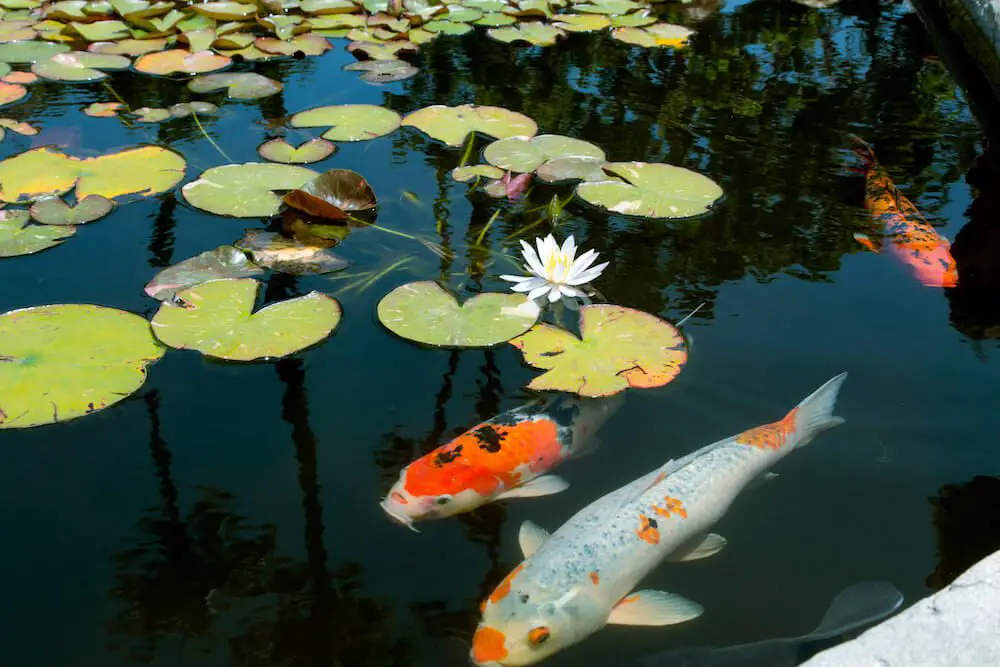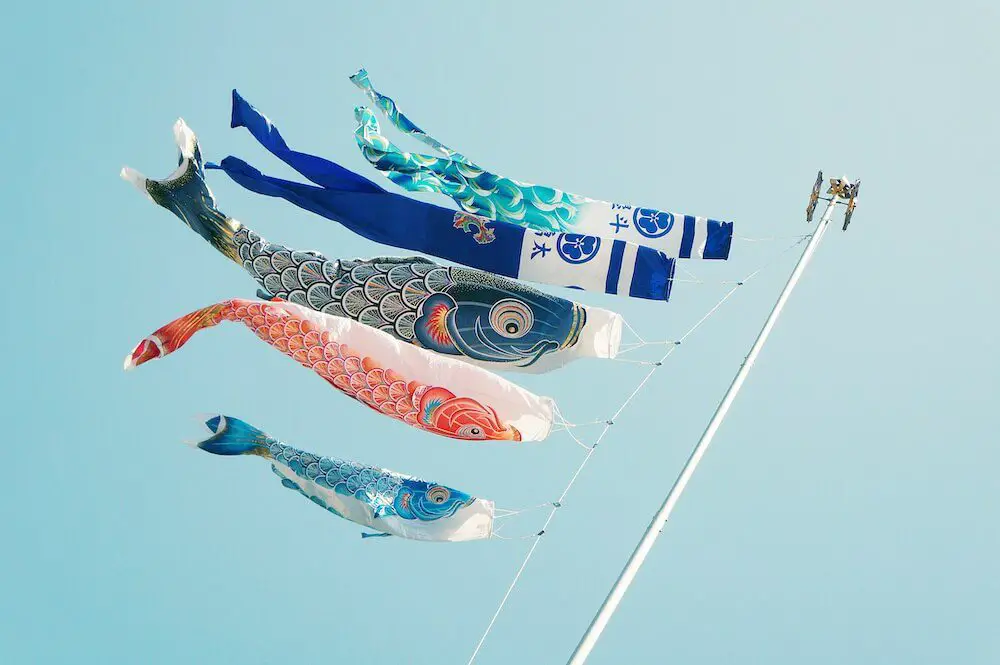Have you ever seen a vibrant orange-and-white koi fish swimming in an ornamental pond? Do you know what the symbol behind it means? In Japan, where these fish originate from, the meaning of koi has strong spiritual and cultural connections.
Much Japanese art and culture use the Koi fish symbol; the koi fish is a significant symbol in Japanese culture. In Japan, the koi fish symbolizes luck, prosperity, good fortune, strength, perseverance – everything good. The Koi fish symbol is very closely associated with the Japanese cultural identity. The word ‘Koi” is a Japanese word that means carp fish.
Table of Contents
- Japan and The Koi Fish
- Koi Fish History
- Koi Fish Legends
- Japanese Cultural Symbols Of The Koi Fish
- Koi Fish And Art Of Tattoos
- 10 Fascinating Facts About Japanese Koi Fish and Their Enduring Charm
- Frequently Asked Questions
- Related Questions

Japan and The Koi Fish
In Japan, the koi fish or koi carp fish symbolizes luck, prosperity, good fortune, strength, and perseverance in facing adversity. The ornamental koi fish symbolizes Japanese culture and Japan’s country identity.
The Koi is also known as Nishikigoi, which means the brocaded carp. You will find it is also referred to as the koi carp fish.
The word Koi is a Japanese word that means carp. There are many varieties of Koi, but the ornamental Japanese Koi carp was introduced in Japan in the 1920s in the Niigata Prefecture on Honshu island.
This fish is usually kept in outdoor koi ponds or water gardens for decorative purposes. You can find many Koi in decorative gardens throughout Japan and even the world.
The koi are ideal for outdoor life as they are coldwater fish that can adapt to many climate and water conditions. This makes them ideal domesticated fish for a place like Japan.
The popularity of the koi is not just limited to Japan. Koi fish are now found worldwide, especially in China and other parts of Asia.
The United States and Europe have koi fish clubs, and koi fish shows. This shows the ornamental koi fish’s popularity has gone outside the borders of Japan and to many other parts of the world.

Koi Fish History
The Koi carp may be an important symbol in Japan, but the fish first came to China 2500 years ago. The koi were popular with the rice farmers as they could be kept in the rice ponds above the rice paddy fields and then eaten as a food source.
Not until many centuries later did the Chinese introduce the koi fish to Japan. At first, the koi fish were eaten as a source of food. This is why the word koi in Japanese still means carp and is still used as a word for all kinds of carp fish, not just the brightly colored ornamental fish that we recognize as the koi fish of today.
In the early 19th century, Japanese farmers noticed color changes in some koi fish specimens and began breeding more colorful koi fish as pets than food sources. Because of how beautiful the fish are, many legends surround the koi fish.

Listen To Our Podcast About Koi Fish – The Importance And Symbolism below or by clicking here.
Koi Fish Legends
Because of how beautiful the fish are, many legends surround the koi fish. There are traditional legends of koi fish in both the Chinese and Japanese cultures.
One legend describes how the well-known Chinese philosopher Confucius was given a black koi on his son’s birth. According to legend, all bright-colored koi are descendants of the koi fish that Confucius was given.
Another legend tells a story at the Dragon’s Gate waterfall at the Yellow River; the koi fish are so strong that the fish can swim upriver and even up to the top of the waterfall. The koi fish that reach the top of the waterfall becomes a mighty dragon.
In Japanese culture, another legend says that the koi fish could conquer waterfalls. This is because the Japanese believe the koi fish to be as brave as samurai warriors.

Japanese Cultural Symbols Of The Koi Fish
In Japan and the Asian culture, there are many things that the koi fish represent. The symbols of the koi fish are almost as varied as the fish itself. This is because the Koi fish means all things positive and good.
Here Are Some Of My Favorite Symbols Of The Koi Fish:
Koi Fish Symbolize Perseverance
The Koi fish symbolize perseverance because the Koi swim upstream and never stop moving. The koi will resist going with the flow and will push against the water currents.
The Koi show us when someone faces adversity, they should not stop or give up but instead keep ongoing; the koi fish keeps on moving even when going against powerful currents. The koi fish symbolizes the strength to persevere through all the hard times.
Koi Fish Symbolizes Strength
Because the Koi fish can swim upstream, they symbolize strength and steadfastness in adversity. The koi fish remain strong even when abysmal odds are stacked against them.
The strength of the koi fish also includes the strength of character. The koi can accomplish everything they set forth to accomplish. The koi fish works to overcome obstacles until they have the ultimate victory in facing adversity.
The koi are so strong that they can even climb steep waterfalls. In Japanese culture, it can even turn into a mighty dragon.
Koi Fish Symbolize Good Luck and Fortune
Koi fish also symbolize good luck and fortune. This is why a factory in many parts of Asia may have a koi fish pond to bring them good luck and fortune.
Many believe having the white koi fish in your home or workplace will help bring good fortune and luck. This is because the koi fish is a symbol of all things good.
Koi Fish And Art Of Tattoos
Koi fish is a popular symbol or tattoo that many people get. In the traditional Japanese culture, tattooing was a spiritual process that would not be undertaken lightly by the person giving or getting a tattoo.
Today, many places, such as public pools or hot springs, will ban those from entering with visible tattoos, no matter how small they are. Japan has outlawed tattooing. Even as far back as the late 19th Century, Japan started to ban tattoos. In 1948, Tattooing became legal again, but there is still a considerable stigma associated with the Japanese art of tattooing. It is legal to receive a tattoo in Japan but illegal to give it to another person.
This is interesting as the koi fish is an essential symbol of Japanese culture. And because of its symbolism, the koi fish is also a popular tattoo for many people worldwide.
The color of the Koi carp tattoo is considered very important. Here are some colors and symbols of the koi fish:
- Black Koi – The black koi symbolizes overcoming adversity, love, and transformation.
- Blue Koi – The blue koi symbolize masculity and virility.
- Red Koi – Red koi symbolizes energy.
- Silver Koi – A silver koi represents success in business and wealth.
- Gold Koi – The gold Koi represents wealth and prosperity.
- White Koi – One of the most important Koi in the world is the white Koi, which has a red spot on the head; these Koi represent patriotism and are a good omen as they symbolize the Japanese flag. A white Koi with red around its mouth represents love and a long-lasting relationship.
- Pair of Koi – A pair of Koi can represent yin and yang (male and female), representing good luck or a happy marriage. Yin and Yang also symbolize harmony in life.
Interestingly, the koi fish symbol can change from person to person because the koi fish ultimately represents all that is good.
So, no matter what the koi fish symbolizes to you, the truth is that the koi fish are and continue to be significant symbols in Japanese culture and throughout the world.
10 Fascinating Facts About Japanese Koi Fish and Their Enduring Charm
With their vibrant colors and graceful movements, Japanese Koi fish are more than just ornamental fish. They are embodiments of Japanese culture, history, and artistry.
Dive into the intriguing world of Koi with these ten captivating facts:
- Symbolism of Strength and Perseverance: Koi fish are often associated with qualities of courage and determination. This association stems from legends where Koi swam upstream and transformed into dragons after overcoming a waterfall, symbolizing triumph over adversity.
- Variety of Colors and Patterns: Koi fish come in various colors, including white, black, red, yellow, blue, and cream. The distinct color patterns and combinations have specific names, such as Kohaku, Sanke, and Showa.
- Centuries-old History: Koi fish have a history dating back centuries in Japan. While carp domestication started in China over 2000 years ago, Koi’s ornamental cultivation began in Japan in the 1820s.
- Living Art Pieces: Koi breeding is considered an art form. Breeders and enthusiasts spend years perfecting the patterns and colors of the fish, much like artists working on a canvas.
- Long Lifespan: Koi fish can live for several decades with proper care. Some legendary Koi have been known to live for over 200 years, although a lifespan of 25-35 years is more common.
- Cultural and Spiritual Significance: Koi fish hold significant spiritual importance in Japanese culture. They are often seen as symbols of luck, prosperity, and good fortune.
- Popular in Celebrations: The Koi fish is an essential motif in celebrations, especially during “Children’s Day” (a part of the Golden Week in Japan). Colorful Koi streamers, known as “Koinobori,” are flown to wish children a life of perseverance and strength.
- Coveted Across the World: The allure of Koi fish isn’t just limited to Japan. Koi keeping and breeding have become popular worldwide, leading to international Koi competitions where prized fish are showcased and judged on their beauty and patterns.
- A Lucrative Investment: High-quality, rare Koi can fetch exorbitant prices, sometimes amounting to hundreds of thousands of dollars. They are viewed not only as pets but also as valuable investments.
- Relaxation and Mental Well-being: Watching Koi glide gracefully through water is believed to help reduce stress and induce a sense of calm. This therapeutic effect has made Koi ponds popular in gardens, temples, and public spaces in Japan and beyond.
The Japanese Koi fish transcends its ornamental status. It’s a symbol, an art, and an embodiment of various cultural and spiritual values. Koi’s timeless charm and profound significance make them truly beloved, not only in Japan but globally.
At A Bus On A Dusty Road, we talk about history, travel, life, sailing, and ex-pat living. We are all about “Living Life As A Global Citizen.” We explore social, cultural, and economic issues and travel.
We would love to have you be part of our community. Sign up for our newsletter to keep up-to-date by clicking here. If you have any questions, you can contact me, Anita, by clicking here.
Listen to our Podcast called Dusty Roads. You can find it on all major podcast platforms. Try out listening to one of our podcasts by clicking here.
Subscribe to our A Bus On A Dusty Road YouTube Channel filled with great videos and information.
Frequently Asked Questions
What is a koi fish?
A koi fish is a type of ornamental fish that is often kept in ponds for its beauty
What is the meaning of koi fish in Japan?
In Japan, the koi fish is a symbol of good fortune, success, and perseverance.
What is the history of koi fish in Japan?
Koi fish were first bred in China and then came to Japan. Koi fish were bred in Japan in the 1820s. They quickly became popular due to their beautiful colors and patterns.
What is the significance of the different colors and patterns of koi fish?
Different colors and patterns of koi fish can have different symbolic meanings. For example, a red koi fish represents love, while a black koi fish represents overcoming obstacles
What is the difference between koi fish and carp?
Koi fish are a type of carp that have been selectively bred for their ornamental qualities.
What is the relationship between koi fish and Japanese gardens?
Koi fish are often kept in Japanese gardens as a decorative element. They are believed to bring good luck and positive energy to the garden.
How are koi fish cared for in Japan?
Koi fish are typically kept in ponds that are designed to mimic their natural habitat. They require clean water, adequate space, and a balanced diet.
How are koi fish viewed in other cultures?
Koi fish are also highly regarded in Chinese and Korean cultures, where they are seen as symbols of good luck, prosperity, and success.
Can koi fish be kept as pets?
Yes, koi fish can be kept as pets, but they require special care and maintenance due to their size and specific needs.
What is the meaning of koi fish tattoos?
Koi fish tattoos are often seen as symbols of strength, perseverance, and good luck. The direction that the fish is swimming can also have symbolic meaning, such as swimming upstream representing overcoming obstacles
Related Questions
How Long Did It Take to Build the Whole Great Wall of China?
The Great Wall of China took over 2,000 years to build. The building span many Chinese Dynasties for about 22 centuries. The construction of the wall ended in the Ming Dynasty in 1644. The Great Wall is one of the largest human-made construction projects globally; the Great Wall is over 21,196 kilometers or 13,171 miles. There are over 25,000 watchtowers scattered throughout the Great Wall structure.
You can read more about the Great Wall of China, but read How Long Did It Take to Build the Whole Great Wall of China? by clicking here.
How Many Vietnam War-era Bombs Are Still in Vietnam?
It is estimated that at least 350,000 tonnes of bombs or about 5% of Vietnam War-era bombs remain in Vietnam. At the present clear-up rate of the explosives, it will take at least 300 years to remove the unexploded ordinances from Vietnam’s landscape.
You can discover more by reading How Many Vietnam War-era Bombs Are Still in Vietnam? by clicking here.

